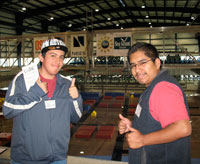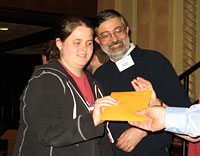You are here
High School Students Take on Tsunami Challenge
04/18/08 Corvallis, Ore.
 Students give the thumbs up for the Wave TankThe students watched as the tsunami hurtled towards the structures. When the waves crashed into them, there was a chorus of “oohs” and “ahs” from the crowd. They were not watching a scene from the movie "The Day After Tomorrow,” but a large scale tsunami simulation inside the O.H. Hinsdale Wave Research Laboratory at Oregon State University (OSU). This was one of the educational experiences at this year’s SMILE High School Challenge.
Students give the thumbs up for the Wave TankThe students watched as the tsunami hurtled towards the structures. When the waves crashed into them, there was a chorus of “oohs” and “ahs” from the crowd. They were not watching a scene from the movie "The Day After Tomorrow,” but a large scale tsunami simulation inside the O.H. Hinsdale Wave Research Laboratory at Oregon State University (OSU). This was one of the educational experiences at this year’s SMILE High School Challenge.
The SMILE High School Challenge is sponsored by the Science and Math Investigating Learning Experiences (SMILE) and supported in part by the Center for Coastal Margin Observation and Prediction (CMOP) and the Cooperative Institute for Oceanographic Satellite Studies (CIOSS). The theme for the year was the science of tsunamis: where they originate, how they affect coastlines, how we predict their occurrence, and how we protect coastal residents from their impacts.
Approximately 120 students from 11 schools around the state took part in the challenge on April 17th and 18th. They were broken up into 12 challenge teams. Their goal was to create a tsunamis awareness campaign that would include a poster, interpretive sign and 30-second Public Service Announcement (PSA).  Student PSAs
Student PSAs
View PSA 1 View PSA 2 The Challenge began on Thursday night at Western Oregon University where the student teams were created, and where the students had the opportunity to meet “experts” and learn a little background about Tsunamis. Also, they had the chance to eat college cafeteria food and sleep in a dorm! The next morning they boarded buses to OSU, for a day of learning and problem solving.
The morning sessions were designed to help them prepare for their campaign. The students participated in lectures on Tsunami monitoring, engineering and modeling. They took a tour bus over to the Wave Lab and got to see first hand the physical force of a tsunami. They also gained insight into the strategies for producing a PSA.
 Dr. Baptista with student winnerThe student teams then gathered in the OSU Memorial Union Ballroom to assemble their tsunamis awareness campaign. With only a few hours to complete the challenge, they moved quickly to grab poster boards, colored paper, markers, and other materials. They drew, cut and clued their props together. At designated times, they had to be ready to record their PSA’s. All twelve groups finished on time with extraordinarily creative campaigns.
Dr. Baptista with student winnerThe student teams then gathered in the OSU Memorial Union Ballroom to assemble their tsunamis awareness campaign. With only a few hours to complete the challenge, they moved quickly to grab poster boards, colored paper, markers, and other materials. They drew, cut and clued their props together. At designated times, they had to be ready to record their PSA’s. All twelve groups finished on time with extraordinarily creative campaigns.
António Baptista, Ph.D., director of CMOP, gave a heart felt talk during the closing portion of the High School Challenge. The students listened intently as he told them about the struggles he endured trying to go to college. He encouraged them to "follow their dreams, no matter what obstacles and challenges they may encounter."
Written by Jeff Schilling
##
About The Center for Coastal Margin Observation & Prediction
The Center for Coastal Margin Observation & Prediction (CMOP) is a National Science Foundation Science and Technology Center. CMOP is creating a new paradigm for conducting coastal-margin science. It is anticipatory rather than reactive, and is based on the emerging power of structured integrations of information, methods and people. The center is a collaborative effort of many academic and industry partners, lead by Oregon Health & Science University (host institution), Oregon State University, and University of Washington.






